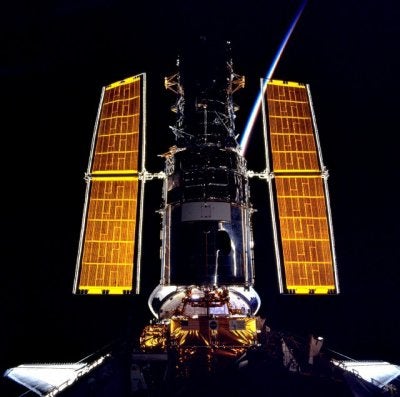Nothing spells triumph in the face of adversity like HST. In 1990, the Hubble Space Telescope couldn’t have sunk any lower in the public eye if it were back on the ground, as embarrassing mirror foibles became fodder for late-night comedians. But just 3 years and a successful, highly televised rescue mission later, HST was better than new with a fresh set of corrective optics. And in the ensuing decade since that first space shuttle service mission, HST pulled double duty to become what it is today — a cultural and scientific icon that has magnified our understanding of the cosmos while rekindling the fires of wonder for billions around the world.
HST’s replacement, the James Webb Space Telescope (JWST), is queued up for launch in 2011. And in light of a new flagship waiting in the wings, HST’s exemplary service record and the telescope’s nostalgic value, NASA made preliminary plans to fetch the aging observatory with a shuttle in 2010. But the Columbia tragedy earlier this year changed everything. What once seemed appropriate and honorable is now too risky and expensive. The consequence: HST will be sent to a watery grave in the Pacific Ocean. The question becomes when and how.
To help answer that question, NASA recently convened an independent panel of astronomers to review the agency’s latest plan, which would retire HST in 2010 with one more service mission scheduled for 2005 or 2006. The panel was charged with making recommendations for maximizing scientific input, while preparing the aging observatory for controlled descent to Earth. Chaired by John Bahcall from the Institute for Advanced Study in Princeton, New Jersey, the panel gathered written and oral testimony and weighed multiple factors, including the potential for a delayed launch of JWST and the cost and danger associated with shuttle servicing missions.
The panel’s recommendations, released late last week, present a spectrum of possible scenarios. The most optimistic one calls for two more shuttle servicing missions — one in 2005 and another in 2010. The most pessimistic scenario involves no more shuttle visits to HST and would send a robotic mission to attach a propulsion system to the spacecraft that would carefully bring it down when science is no longer possible.
From the onset, HST was designed to be a serviceable space observatory. In fact, its orbit is low enough that without periodic boosting to higher altitude by the shuttle, the telescope would re-enter the atmosphere in an uncontrollable and fiery descent to Earth. Without another service mission, this could happen as early as 2013. With more service missions, though, HST could produce meaningful science results well beyond 2010, as there is little evidence of degradation in the optics and other crucial operations packages.
NASA administrators are reviewing the panel’s recommendations and hope to unveil a final plan for HST soon.










